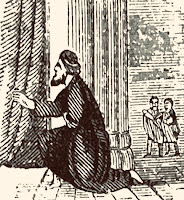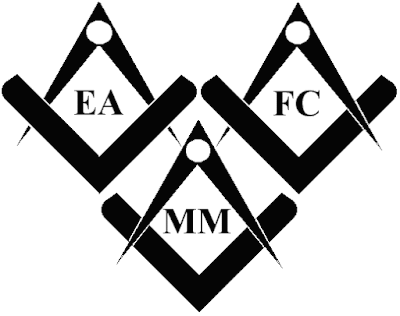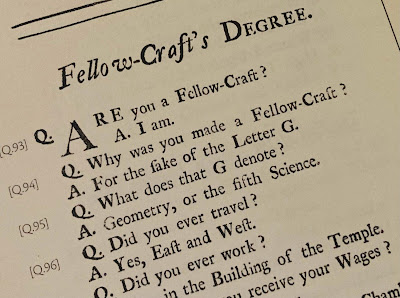 |
| Magpie file photo |
Wednesday, November 5, 2025
‘2026 Prestonian Lecture’
Saturday, November 2, 2024
‘Masonic Hall Monitors at The ALR’
 |
| Thomas Smith Webb by Travis Simpkins. |
What better way to commemorate the anniversary of Thomas Smith Webb’s birth in 1771 than to attend your research lodge for a dive into the history of Freemasonry’s ritual literature?
In truth, Webb’s birthday was the following day. Regardless, we think we arrived at the reason why exoteric ritual books are commonly called monitors: Because Webb titled his The Freemason’s Monitor; or, Illustrations of Masonry: In Two Parts, and the moniker “monitor” stuck.
 |
| etymology.com |
The origin of the word “monitor” shows it derives from the Latin for “one who reminds, admonishes, or checks,” also “an overseer, instructor, guide, teacher,” according to etymology.com, so the term is apt, and seems to have become the aptonym many grand lodges use to title their books of exoteric Masonic rituals (charges, funerary ceremony, cornerstone dedication, etc.). Others call them manuals. How boring.
 |
Wonderbook 1942 GLNY Monitor |
 |
| Sam Kinsey |
 |
| Michael LaRocco |
 |
| Ben Hoff |
 |
| Macoy Masonic Supply Co. |
I had planned on giving a fourth talk on the subject of Macoy Masonic Supply’s reprinting of Robert Macoy’s 1867 Masonic Manual, but it seems the 750-book run has sold out, and I didn’t want to promote something the brethren cannot buy. It’s pretty cool, though.
Tuesday, June 4, 2024
‘History by type and as ritual’
 |
| The Spirit of Masonry, essential reading, figures in Ben Hoff’s upcoming paper. |
New Jersey Lodge of Masonic Research and Education 1786 will meet Saturday. Two weighty papers are scheduled. From the trestleboard:
“Classifying History Writing by Type” by Bro. Donald Elfreth. This admittedly subjective short essay attempts to fit various types of history writing into four broad areas. There are no firm divisions of these areas, and each may have, to some extent, elements of another. The presenter does not expect all to agree with his analysis, and he looks forward to a lively discussion at the conclusion of his presentation.“Monitors and Ritual Ciphers” by Distinguished Laureate Bro. Ben Hoff. A survey of history and development of Masonic Monitors and Ritual books, both coded (ciphers) and uncoded, along with their influence on the expansion of our ritual, particularly lectures.
Wednesday, February 14, 2024
‘Scottish EA° Working Tools’
My lodge had the honor of initiating two candidates for the mysteries of Freemasonry Monday night. I’ve always enjoyed the variety shown in rituals around the Masonic world; the following example offers not only different language in defining the familiar Working Tools of the Entered Apprentice Mason, but also reveals a Working Tool unknown to lodges in the United States.
Tuesday, February 13, 2024
‘Remember the great objects of our association’
 |
| Chuck Dunning |
Sunday, February 4, 2024
‘The return of Macoy’s Masonic Monitor’
 |
| Front cover, I assume, of the book. |
Macoy Masonic Supply Co. of Virginia (formerly of New York City) will publish a seminal work by its founder soon in commemoration of the business’ 175 years, and thoughtfully invites us to purchase the painstakingly reproduced historic volume. This is Robert Macoy’s Monitor from 1867. From the publicity:
According to Coil’s Encyclopedia, “A monitor is a book of esoteric ritualistic matter. Virtually all…of the moral and ethical instructions of Freemasonry is contained in the published…monitors and manuals issued by various Masonic authorities. Such publications (are not) the secret parts of the ritual. The most prominent of the monitors were Preston’s of 1772; Webb’s of 1797: Cross’ of 1819: Tannehill’s of 1824; Mackey’s of 1852; and Macoy’s of 1867.
Tuesday, October 24, 2023
‘Masonic Unity Day in January’
Masonic Hall will be the venue next January when Grand Lodge will host brethren from the grand lodges of Delaware, Pennsylvania, and New Jersey for a daylong exemplification of the Craft degrees. From the publicity:
Monday, October 9, 2023
‘Emulation Ritual’s bicentenary’
 |
| emulationloi.org |
I wanted to get to this last Monday, which was the actual 200th anniversary, but anyway I’ll note the landmark occasion of the start of Emulation Lodge of Improvement on October 2, 1823 thusly.
 |
| Seal of the Ancients. |
 |
| Peter W. Gilkes |
About the year, 1823, several Brethren considered that the Masonic lectures were not worked in the Lodges upon a sufficiently regulated system, and that if those whose attainments as working Masons placed them as a prominent authority, were to meet together and to work efficiently, they might be the means of effecting much improvement. They accordingly met, we believe in Wardour Street, pursuant to a general notice in the public papers, which advertisement created a considerable sensation in the Craft. Some members of the Grand Stewards’ Lodge, hitherto the only authority for a recognized system, felt that it was necessary to watch the proceedings. Some Grand Officers, with Brother E. Harper, the Grand Secretary, also attended. The several chairs from the Master to the Outer Guard were all filled with the most practical and experienced Masons of the day; and we have the authority of a Grand Officer for stating, that never was there so perfect an illustration of the ceremonies and lectures ever before manifested. The visitors separated, highly delighted; and among them, the lamented Peter Gilkes, who so highly approved of the proceedings, that, in about twelve months afterwards, he joined the Lodge, and supported it until the time of his death.
If I’m not mistaken, Emulation can be found in America, in certain lodges that adhere to either the Observant or European Concept models. I think Vitruvian 767 in Indianapolis works it. Many years ago, when Marco became Master of St. John’s 1 in Manhattan, he was installed by a Board of Installed Masters of the Emulation style. Needed dispensation for that.
 |
| One of many Emulation books. |
Sunday, October 1, 2023
‘Ritual: script or oral history?’
 |
| Title page of Grand Lodge’s current book. |
A Past Master in Kansas, a DDGM actually, regularly offers his views on things Masonic, kind of in blog format, on Faceypage. He posts in “A Past Master’s Thoughts” almost daily. About a month ago, in reflection on a lodge experience the day before, he wrote:
The topic of ritual came up. It seems there is a lodge that requires ‘word perfect’ ritual. Let me say I get that, but even Grand Lecturers stumble… It was brought up the difference between perfect and proficient. There is a difference.
Do you know the work? Does it resonate with you? Ritual is energy. Can it be felt, or are we just spewing words?
For those who say they cannot learn ritual, I have a few questions: Do you know your address without looking it up? Your phone number? If your favorite song came on the radio, but the volume turned off, could you sing it? If you said yes to any of those, you can be proficient, at least, in ritual.
 |
| From ‘A Past Master’s Thoughts.’ |
How many inept leaders have you seen win high office for no other reason than their demonstrated ritual skill? When the fraternity was larger (if you don’t know, the number of regular Master Masons in this country has returned to nineteenth century levels), obviously there was more talent to provide the ritual experts needed for continuity of the work. And having the book isn’t enough; we need the “actors” to bring the written word to life. This isn’t as easy today, thanks to changes in how the young are schooled. The rote memorization, aided by mnemonics, that older people, like myself, relied on appears to have been retired. (I don’t know if something else has replaced it.) So the task of studying, learning, and recalling Masonic oratory, which never was easy for most, looks today like an unduly difficult and outdated method to a thirty-year-old. Generally speaking. I always see exceptions.
Friday, August 18, 2023
‘Judaism and the lodge’
On the strength of his lecture last month at Masonic Con Kansas, W. Bro. Matthew Parker, Master of Nebraska Lodge 1 in Omaha, was the guest on yesterday’s Masonic Roundtable podcast to discuss “The Jewish Essentials of Freemasonry.”
Thursday, May 11, 2023
‘What’s the deal with…?’
 |
Castle Rock Entertainment ‘What’s the deal with…?’ |
“I also present you with a new name; it is Caution; it teaches you that as you are barely instructed in the rudiments of Masonry, that you should be cautious over all your words and actions, particularly when before the enemies of Masonry.”Illustrations of Masonry“First Degree Initiation”William Preston
When I was brought into the fraternity, this was not done. There was no social media or even much of an internet at that time, but the lodge would publicize things in the local newspapers—but never the names and faces of candidates.
Saturday, February 11, 2023
‘Possible Influence of Plato’s Works in Masonic Ritual’
Thursday, September 29, 2022
‘1730 Fellow-Craft’s Degree’
Thank you for reading The Magpie Mason. Today, we begin our fifteenth year together.
Publicity Lodge 1000 returned from its Summer Refreshment on Monday the twelfth, beginning a new year of Masonic labor. The Magpie Mason was scheduled to present a discussion of Masonic educational value, so, with a Ceremony of Passing on the trestleboard for an upcoming meeting, I chose the Fellow Craft Degree as that topic of conversation. And not just any second degree, but the one printed in 1730 by one Samuel Prichard in his essential ritual exposure Masonry Dissected, newly published by the Masonic Book Club. Masonic rituals, Masonic lodges, Masonic grand lodges, Masonic everythings were very different 300 years ago. All of it was very basic compared to what we have today.
I explained how when Masons think of lodges, we understandably envision the modern lodge room, with its varied furniture, seating arrangement, equipment, décor, etc., but things were primitive in the early eighteenth century when lodges met in tavern dining rooms or in private homes. There were no tall pillars flanking the Inner Door (there was no Inner Door!), and instead the brethren spoke ritually of J and B, explaining their purposes and describing their looks, using language similar enough to what we know today.
I told the lodge I was going to read the ritual of the degree. Read the ritual?! That could take hours! Yet the ritual of that period was very basic as well, consisting of a call-and-response dialog among the Worshipful Master and the brethren (not unlike our current Opening and Closing rituals) that spans only five pages of the MBC edition. The Fellow Craft Degree of 1730 included no elaborate floor work, no lengthy monolog lecture or other ceremonious orations, no hoodwink, nor other elements we today expect. Some of those features already were revealed to the candidate during the “Enter’d ’Prentice’s Degree,” and so went forsaken in the second degree. Anyway, reading the entire “Fellow-Craft’s Degree” ritual required only a couple of minutes. I won’t transcribe it all here, but do recommend to you the new book from the MBC. They will have more copies for sale after the subscription sales have been satisfied. (I saw Lewis Masonic had it listed for sale the other day, but it seems to be gone from their website now.)
Unsurprisingly, the letter G is very significant to the degree. I’ll share this brief passage. It rhymes and is in question-and-answer form. The dialog is between the Master and different brethren in the lodge (not the candidate, who wouldn’t be capable of answering), so you really had to know your ritual because you wouldn’t know which answers you’d be expected to recite on any given evening.
Q. Can you repeat the letter G?
A. I’ll do my endeavor. In the midst of Solomon’s Temple there stands a G, a letter fair to all to read and see, but few there be that understands what means that letter G.
Q. My friend, if you pretend to be of this fraternity, you can forthwith and rightly tell what means that letter G.
A. By sciences are brought to light bodies of various kinds, which do appear to perfect sight, but none but males shall know my mind.
Q. The Right shall.
A. If Worshipful.
Q. Both Right and Worshipful I am, to hail you I have command, that you do forthwith let me know, as I you may understand.
A. By Letters Four [the Word of EA] and Science Five [the fifth science, Geometry] this G aright does stand, in a due art and proportion, you have your answer, friend.
Q. My friend, you answer well, if Right and Free Principles you discover, I’ll change your name from friend, and henceforth call you Brother.
A. The Sciences are well composed of noble structure’s verse, a Point, a Line, and an Outside, but a Solid is the last.
Q. God’s good greeting be to this our happy meeting.
A. And all the Right Worshipful Brothers and Fellows.
Q. Of the Right Worshipful and Holy Lodge of St. John’s.
A. From whence I came.
Q. Greet you, greet you, greet you thrice, heartily well, craving your name.
A. (Candidate gives his name.)
Q. Welcome, Brother, by the grace of God.











































































